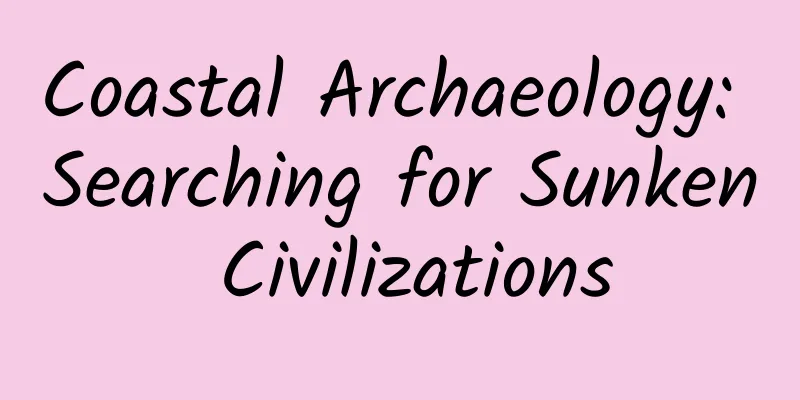Coastal Archaeology: Searching for Sunken Civilizations

|
Part of human history lies in the seabed corals, sea turtles, and tiger sharks up to four meters long... Australia's Dampier Islands attract tourists from all over the world with its charming scenery and a variety of wildlife. But what tourists don't know is that there are hidden wonders under this sea that even experienced tour guides have never heard of. In 2019, some stone tools left on the seabed caught the attention of scientists who came here to dive. The last time these stone tools were held in the hands of humans was at least 7,000 years ago. The discovery of underwater stone tools made scientists ecstatic because it was an extremely rare discovery. Thousands of years ago, the sea level here was much lower than it is today. Today, large areas of coastal continental shelves were once places where human ancestors lived. Due to the great difficulty of underwater archaeology, most of the ancient human remains hidden underwater have not been excavated, which has led to a huge gap in ancient human history. Now, the situation has changed. Through underwater archaeology, scientists have restored the details of the life and hunting of Stone Age humans in the coastal zone, and also learned that these ancient humans once tried to prevent the rise of sea levels at all costs. What is coastal archaeology? Underwater archaeology can be traced back to the 19th century. In the past, people mainly explored ancient maritime activities by excavating sunken ships; now, scientists are searching for underwater relics on a larger scale. For example, Australian scientists launched the "History of the Sea Country" scientific expedition project, part of which is to conduct underwater archaeology in the Dampier Islands. The seabed is actually not ordinary at all. In the eyes of underwater archaeologists, the seabed is scattered with the remains of ancient human life. After the glacial maximum about 20,000 years ago, the rising sea level has swallowed up at least 20 million square kilometers of land in the world - as large as the entire North America. Some people even call these fragmented lands "water continents." Surprisingly, these stone tools buried underwater are better preserved than artifacts on land. This is because industrial development has caused less damage to underwater sites. However, collecting tiny bone and stone tools on the boundless seabed is like looking for a needle in a haystack. The bulky diving suits and fins increase the difficulty of divers' underwater activities, and their vision is often obscured by the stirred-up silt. Wind farms help investigate. Although underwater archaeology is difficult, it is not impossible. Let's look at Doggerland (which once stretched from the east coast of the UK to the Netherlands, the west coast of Germany and the Jutland Peninsula, and was an important land bridge connecting the UK and the European continent). This fertile land, once full of swamps and rivers, is now submerged by the North Sea. Over the years, with fishing boats and regular sand mining operations, ancient stone tools here have been dug out bit by bit. One of the unexpected discoveries included 33 hand axes, some mammoth and bison bones. A British archaeological company started from this and traced it back to the discovery site, Area 240, about 11 kilometers off the east coast of England. The maximum water depth there is 35 meters, while the safe diving depth for scuba divers is only 30 meters at most. So the archaeological company dispatched dredgers to collect sediments and then carefully screen them. In 2014 alone, they found a large number of flint stone tools dating back 200,000 years ago from the area. Underwater sites like Area 240 are still very rare. Humans still have a long way to go to determine underwater sites like Area 240 based on the seabed topography. Some people use the analogy of finding an embroidery needle in a haystack to describe the difficulty of identifying underwater sites. In fact, it is not difficult to find an embroidery needle with the help of a metal detector. The difficulty lies in finding a haystack with a needle. This work is expensive, and the daily rental fee for the boat alone is a considerable expense. Fortunately, as more and more offshore wind power stations are erected in British waters, the underwater archaeological surveys of the surrounding areas completed by these companies before building wind turbines have saved archaeologists a lot of time. Embrace the Coast Many archaeologists believe that instead of focusing underwater archaeology on deep waters with complex topography, it is better to focus on coastal areas. With simple scuba training, most scientists can dive to less than ten meters to conduct archaeological research. There are some stone sculptures in the waters off the Dampier Islands that resemble the long-extinct Tasmanian tiger. This shows that these relics can be traced back to 20,000 years ago. However, the most interesting thing is probably the underwater stone tools, including stone hammers and knife-like "stone flakes". The average size of these underwater stone tools is larger than the stone tools unearthed nearby on land. These ancient processing techniques are unprecedented. Such archaeological excavations are of great significance to the local area. Although some archaeologists believe that it is not worth the cost to spend huge sums of money just to find some broken stones, more and more scientists are beginning to realize the importance of coastal archaeology. For example, surveys of coastal caves in South Africa over the past 20 years have shown that humans have been eating seafood since 100,000 years ago. At the same time, the exquisite paintings and jewelry created by these ancient humans show that they already have creativity close to that of modern humans. Therefore, some researchers believe that there is a causal relationship between eating seafood and making handicrafts. They point out that seafood is rich in nutrients such as omega-3 fatty acids that are beneficial to brain development. Many scientists firmly believe that eating seafood laid the foundation for humans to enter modern society. 100,000 years ago, ancient humans migrated from their African homeland to all parts of the world. Scientists generally believe that the coastal zone served as a major transportation route in this process. The Monteverde site in southern Chile has a history of 14,000 years and is one of the earliest remains of human settlement in the Americas. It is speculated that ancient humans first entered the American continent from Alaska, and then they migrated along the rivers all the way to the coastal zone on the edge of the continent. The geographical location of the Monteverde site on the coast fits this speculation. Archaeologists once believed that after human ancestors crossed the Bering Land Bridge between Siberia and Alaska, they dispersed to plains throughout the interior of North America. But judging from the archaeological evidence of the coastal zone discovered so far, the situation at the time may be very different from what was thought in the past. Rising sea levels Ancient humans fought against the coastal land being swallowed up by the sea bit by bit. What measures did ancient humans take to ensure that their living conditions would not be further damaged? In 2019, Israeli underwater archaeologists published a paper describing a seawall at the 7,000-year-old site of Jerez. Today, the seawall is located 4 meters below the sea surface and 90 meters from the coast. The long embankment is located on the seaside of the site and seems to be used to resist seawater erosion. This shows that humans began to set up coastal defenses at least 7,000 years ago. Building a seawall is not an easy task, as some of the boulders weigh more than a ton. Even so, the seawall failed to stop the invasion of seawater, and Jerez was abandoned after only a few generations. But it at least shows that ancient humans attached great importance to settling by the sea, and tried to protect their homes from the waves at all costs. The Isles of Scilly, off the southwestern tip of England, provide more evidence for this. The islands are home to many historical sites, including hundreds of cairns, stone monuments and tombs. A scientific expedition team conducted an investigation here in 2020 and found that 36% of the land on the island was submerged by the sea four or five thousand years ago. But archaeological evidence shows that the reduction in land did not weaken the activities of humans living there. On the contrary, ancient humans built more monuments during this period. Considering that rising sea levels are increasingly threatening the homes of ancient islanders, some scholars speculate that the abnormal emergence of megalithic tombs during this period may reflect that ancient humans wanted to continue their civilization in the face of unpredictable nature. Of course, this is just a speculation. It seems easier to guess what the ancient people living in Australia today were thinking. History and culture here are passed down from generation to generation, through knowledge sharing, and passed down orally between families and tribes. Dozens of tribes along the Australian coast still pass on legends about rising seas and sinking land. Scientists have been collecting these stories for years. Each of these diverse coastal tribes has at least one legend about the sea swallowing up the land. Scientists have concluded that these stories point to a period of significant sea level rise in Australia. After the last ice age, a large number of glaciers melted and the sea level rose, which only slowly stopped 7,000 years ago. In other words, these legends may be true accounts. It is no wonder that coastal tribes continue to remember those long-lost lands to this day, given how tragic it was for ancient humans to struggle against the rising sea level. It is not difficult to understand why the locals were not surprised when the scientific expedition team dived underwater and brought back long-silent ancient artifacts. The vastness and abundance of underwater ruins means we still know very little about them. Scientists can't wait to go back underwater to explore more submerged secrets. Underwater Tombs, Caves and Water Homes Underwater archaeology is not only carried out in the ocean, but can also be carried out in some inland waters, but only those who dare to dive can get involved. Pyramid of Nastasen In the ancient Kush Kingdom in Sudan, successive pharaohs built pyramids similar to those in neighboring Egypt. More than 2,300 years ago, King Nastasen built his tomb underwater inside a pyramid. In 2019, a scientific expedition team sneaked into the cave to find out what was going on. They found a thick stone slab, which they speculated was used to cover Nastasen's tomb. Next, they will further explore the secrets behind it. Underwater Skeleton Cave The earliest evidence of human settlement in tropical North America comes from underwater caves in Mexico's Yucatán Peninsula, where archaeologists have discovered several complete human remains, some of which date back 13,700 years. A 2020 study found that four of the remains had subtle differences in appearance, suggesting that early humans in the Americas may have come from distinct populations. Although the circumstances of human initial settlement here remain a mystery, this study provides at least some clues to the puzzle. Ancient artificial island In lakes or estuaries, the Scottish ancestors would build artificial islands called "roundhouses" for settlement. A 2019 study confirmed that the ancients learned this skill thousands of years earlier than we expected. In the waters around several roundhouses on the Isle of Lewis in the Outer Hebrides, divers found Neolithic pottery. According to the results of carbon 14 dating, the charred residue in the pottery is about 5,500 years old. The coastal zone was an important transportation route for ancient humans to migrate. |
<<: Oat milk is several times more expensive than cow's milk. Is it oats or milk?
>>: One of the biggest puzzles of the 21st century: How were the elements formed after the Big Bang?
Recommend
18 time management lessons that high-performance people must learn from a trainer from a Fortune 500 company with an annual income of one million
Wasn’t there the Luo Zhixiang’s multi-person Qigo...
Forest carbon sinks achieve carbon removal and help achieve “net zero emissions”
November 1 is World Afforestation Day. In additio...
Uber is facing a series of crises, and many employees have lost confidence and are looking for new ways out.
According to the online version of the Financial ...
Is the PC on its way out or are manufacturers failing to identify the right needs?
Recently, market research firm Gartner released a...
Android compatibility | NDK toolset update notes
Influenced by other improvements to the Android p...
Some methods and techniques for choosing 400 telephone service
No matter what we do, if we find certain methods ...
Why can many animals walk as soon as they are born, but humans can't?
Audit expert: Mao Xinmei Chief Physician of Pedia...
After the rules of the game for new energy vehicles have changed, Korean batteries are having a hard time gaining a foothold
On March 30, the new energy vehicle battery facto...
Rebellious "performance artists" in the sea: The mystery of striped shrimp "standing upside down" is revealed
If ordinary fish are economy class, then striped ...
Marketing's key: consumer attention
Nowadays, it is difficult for consumers to concen...
Gaining 3 pounds every holiday season? Learn the "10 fists" principle and lose weight without dieting!
After a baptism of delicious food during the Spri...
Do you need to sleep for eight hours? Is it healthiest to go to bed at 10 or 11 o'clock? Finally, there is an answer
Sleep is a repair process for the human body that...
Community operation: operation skills of community content!
Content is the prerequisite for the development o...
Zhengzhou optimization outsourcing, why should enterprises choose SEO outsourcing optimization company?
As we all know, outsourcing is the hiring of expe...
3.5 billion years, the evolution of life on Mars: it is very likely that it will not exceed the single-cell stage!
[Mobile software: Bo Ke Yuan] Undulating land str...









